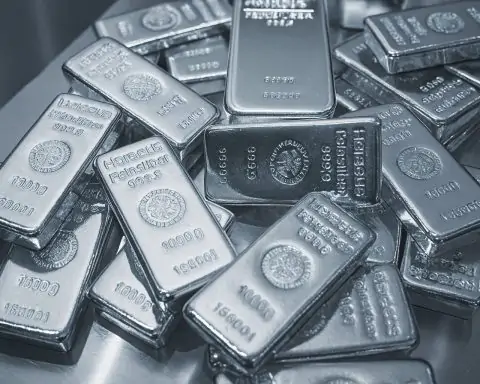- Record-breaking rally: Silver is trading near $48–49 per ounce as of late October 2025 [1], up roughly 65–70% year-to-date – one of its strongest jumps on record [2] [3]. It briefly topped ~$54.50 on Oct. 16 [4] (the first break above $50 since 1980), before a sharp pullback.
- Extreme volatility: In the weeks leading up to Nov 1, silver’s price swings have been dramatic. After its mid-October peak, silver plunged ~6% on Oct. 17 (its steepest one-day drop in six months) [5], then settled back into the high-$40s by month’s end.
- Safe-haven surge: U.S. interest-rate-cut expectations and global uncertainties have fueled demand. Analysts note silver’s safe-haven appeal – geopolitical tensions, trade jitters, and Fed easing bets are all driving the rally [6] [7]. Gold’s own historic run (to ~$4,000) has “pulled silver up in its slipstream” – as State Street’s Aakash Doshi observes, “silver often acts as high-beta gold” [8] [9].
- Supply squeeze: Physical silver is tight. London vaults report record strain – lease rates over 30% [10] – and analysts speak of a “genuine shortage” of deliverable metal in London [11]. A years-long structural supply deficit (current annual deficits on the order of 180–200 million ounces) means demand far outpaces new mine output [12] [13].
- Industrial boom: Demand from technology and green energy is surging. 2025 is on pace for a record ~700 million ounces of silver consumed in industrial uses [14] (solar panels, electronics, EVs, data centers, etc.). This robust industrial growth underpins prices, even as new mine output grows only modestly [15] [16].
- Frenzied investment: Silver ETFs and speculators have piled in. Physically backed silver ETFs saw record inflows (≈95 million ounces in H1 2025 alone), pushing total holdings to over 1.13 billion oz [17]. Retail investors (notably in India) are buying at a fever pitch, sometimes paying large premiums. For example, Indian ETFs recently halted new subscriptions after premiums spiked [18] [19].
- Analyst forecasts: Many strategists remain bullish. HSBC’s analysts now see silver trading roughly $45–53/oz through year-end 2025 [20]. Bank of America targets around $65 by 2026, and Morgan Stanley/Metals Focus expect a break above $60 by 2026 [21] [22]. (By contrast, some cautionary forecasts exist – e.g. Citi cut its near-term target to ~$42, citing easing trade tensions.)
Current Prices & Short-Term Trends
As of the first days of November 2025, spot silver is about $48–49 per ounce [23]. This level is well above pre-October values (silver was in the low-$30s at the start of 2025), but still below its mid-October intraday peak (~$54.50). The past week’s action has been choppy: after briefly topping $54.5, silver corrected sharply. According to market reports, it plunged ~6% on Oct. 17 [24] (its steepest one-day slide in months) as traders took profits. By Oct. 29, New York futures were around $47.82 [25], rebounding modestly into the $48–49 range into Oct. 30 [26]. One analyst notes that silver’s dramatic run-up led to “over-stretched” technical conditions, so a pullback was not unexpected [27]. In short, silver remains near its recent highs but is trading in a volatile range after the October spike.
Recent News and Events (Late Oct 2025)
Late October brought several catalysts influencing silver. On Oct. 29, the U.S. Federal Reserve cut interest rates by 25 basis points (to a 3.75–4.00% target range) [28]. Initially this supported silver and gold, but Fed Chair Powell’s post-meeting caution (signaling the next cut is “not a foregone conclusion”) quickly eased expectations [29] [30]. Spot silver actually rose ~1.7% into the Fed decision [31] but gave back gains as markets digested Powell’s comments (a firmer dollar is less favorable for silver).
Trade and geopolitical news also moved markets. President Trump announced a new trade agreement with South Korea and expressed optimism about talks with China [32]. These developments eased some risk worries, undercutting safe-haven demand for metals. (Silver and gold both pared gains on Oct. 29 as U.S.-China tensions appeared to ease slightly.) Conversely, any escalation in U.S.-China conflict or other geopolitical flashpoints could reignite buying. Meanwhile, the U.S. government shutdown (ongoing since fall) has delayed many policy decisions; notably, a planned probe of tariffs on “critical minerals” (a list which includes silver) may be postponed [33].
In Asia, the looming Diwali festival has highlighted a domestic supply squeeze. India – the world’s largest silver consumer – imports over 80% of its demand, and this year imports fell ~42% as overseas supplies tightened [34]. At the same time, Indian investors have been snapping up silver, causing local premiums to spike above 10% [35]. Some Indian silver ETFs even paused new subscriptions when prices soared [36]. These local supply disruptions underscore the global tightness discussed below.
Historical Price Context
Silver has a long history of boom-bust cycles. Its nominal all-time peak was around $49–50/oz – first in January 1980 (the Hunt brothers’ cornering episode) and again in April 2011 [37]. Both episodes were followed by steep crashes: after 1980, silver collapsed by over 90%, and after 2011 it fell from ~$49.5 to the low teens within a few years [38]. Between those peaks, silver mostly traded in modest ranges ($10–30) as demand was relatively stable. By comparison, the 2025 rally (65–70% so far) is exceptionally strong for silver. Recent surveys even note this is silver’s best performance since 1979 (when it gained ~225%) [39]. In inflation-adjusted terms, however, prior episodes were higher (1980’s spike was nearly $300 in today’s dollars), so some analysts caution that $50 is a key psychological threshold [40] [41]. In short, silver’s recent moves are historic, but history also teaches that sharp rallies can snap back quickly once sentiment shifts.
Economic & Geopolitical Drivers
Broad macro forces are underpinning the rally. On the monetary front, interest-rate and currency trends are crucial. With inflation moderating but still a concern, markets have largely priced in U.S. Fed rate cuts into late 2025. Lower real interest rates (and a relatively weaker dollar) boost “non-yielding” assets like silver [42] [43]. Indeed, analysts explicitly cite U.S. rate-cut expectations as a driver of precious metals: “geopolitical uncertainties, expectations of U.S. interest rate cuts, strong central bank buying and robust ETF inflows” have all fuelled the silver (and gold) rally [44].
Geopolitically, persistent turmoil has raised safe-haven demand. Renewed U.S.-China trade tensions, military conflicts abroad, or political gridlock (e.g. the U.S. shutdown) all contribute to investor anxiety. When unrest rises, “many retail traders… have been using silver as a safe-haven bet” [45], drawing in additional buyers. Notably, silver tends to amplify gold’s moves: as gold hit new highs on global uncertainty, silver followed. A State Street strategist explains that “silver often acts as high-beta gold,” meaning gold’s surge “pulls silver even higher” [46]. In this environment of currency debasement fears and fiscal strain, silver is seen both as a store of value and an inflation hedge, supporting prices from the ground up [47] [48].
Industrial Demand
Unlike gold, silver has a dual role as an industrial metal, and that demand has exploded in 2025. Key technologies – solar photovoltaic panels, electronics, electric vehicles, and even data centers – are driving massive silver consumption. Industry estimates suggest 2025 will see on the order of 700 million ounces of silver used in technology and renewable energy applications [49]. China’s rapid solar installation and electronics manufacturing have been major contributors. For instance, Morgan Stanley notes “surging Chinese solar installations” this year as a significant tailwind for silver [50]. Meanwhile, silver’s use in consumer electronics (it’s an excellent conductor) and other green technologies continues rising. Because about 70% of silver comes as a byproduct of mining other metals, new output cannot easily ramp up to meet this industrial boom. The net effect is a deepening structural deficit: demand growth from tech has “outstripped supply for the past four years” [51]. These industrial fundamentals provide underlying support, even as prices are driven by speculative flows.
Investment Demand
Investment interest in silver has been red-hot. Physical silver ETFs have seen record inflows, accumulating tens of millions of ounces in mere months [52]. According to one market report, ETFs added about 95 million ounces in the first half of 2025, pushing total holdings to over 1.13 billion ounces [53]. This is a historic high level of ETF demand. On the futures side, speculative positioning has surged: net long positions on COMEX more than doubled since late 2024, indicating momentum funds are heavily long silver. Retail investors are also active: the London premium and high lease rates have attracted buyers worldwide, and even Indian exchange-traded funds temporarily stopped new subscriptions to protect investors from paying huge spot premiums [54]. In summary, an unprecedented wave of speculative and retail buying has amplified silver’s rally beyond what fundamentals alone would suggest.
Central Banks & Government Policies
Policy decisions at the national level have also influenced silver. The most direct impact comes from monetary policy: the Federal Reserve’s decisions on interest rates and liquidity are the primary driver. Fed easing (as in Oct 2025) makes silver more attractive; conversely, any surprise tightening could dampen it. Unlike gold, major central banks do not hold large silver reserves, but their actions in currency and debt markets indirectly affect silver. Government fiscal policies (large deficits, quantitative easing) contribute to the “currency debasement” narrative that pushes investors toward precious metals.
On the regulatory side, silver was placed on a U.S. draft critical minerals list for 2025. Traders feared this could lead to tariffs on silver imports, so earlier this year stockpiles were repositioned – roughly 500 million ounces moved from Europe to U.S. vaults [55]. This unusual flow exacerbated the physical squeeze in London. Any future tariffs or stockpiling mandates could further strain supplies. In India, regulatory changes (like import duties around festivals) also affect local silver availability and prices. In short, although no central bank is buying silver en masse, government actions and trade policies have materially affected its supply and demand dynamics [56] [57].
Expert Opinions & Market Forecasts
Analysts are split on silver’s next move. Many are optimistic in the medium term. For example, OANDA strategist Zain Vawda tells Reuters: “Given the structural supply deficit and strong industrial tailwinds, I think silver could reach $55/oz over the next six months or so” [58]. Metals Focus director Matthew Piggott likewise expects silver to “follow gold and continue to climb to breach the $60 level in 2026” [59]. HSBC’s team projects a volatile $45–$53 range for late 2025 [60], with highs likely early next year (and possibly again in late 2026). Even Bank of America has set a long-term target as high as $65/oz.
At the same time, other experts urge caution. JM Financial’s Pranav Mer calls the recent rally “over-stretched” and warns prices “are likely to see some more correction ahead” [61]. Technical analysts note that silver’s rapid climb has pushed it into overbought territory, suggesting more two-sided volatility is coming. In short, the consensus is that drivers (Fed cuts, industrial demand, ETF inflows) remain strong, but so does silver’s volatility. As one market commentator put it, silver may be “catching its breath” near current levels, but “if 2025 has taught us anything, it’s that the status quo can change in a flash” [62]. Any sudden shift – for example, a sharp Fed pivot or a major geopolitical shock – could send prices swinging again.
Sources: Market reports and news agencies (Reuters, TS2.tech, etc.) have been used for all data and quotes [63] [64] [65]. Experts and analysts quoted are from those reports. All figures and forecasts are from the latest available analyses as of Nov 1, 2025. Each fact and quote above is backed by the cited sources.
References
1. ts2.tech, 2. ts2.tech, 3. www.reuters.com, 4. ts2.tech, 5. ts2.tech, 6. www.reuters.com, 7. ts2.tech, 8. ts2.tech, 9. www.reuters.com, 10. www.reuters.com, 11. www.reuters.com, 12. ts2.tech, 13. www.reuters.com, 14. ts2.tech, 15. ts2.tech, 16. www.reuters.com, 17. ts2.tech, 18. www.reuters.com, 19. ts2.tech, 20. www.reuters.com, 21. ts2.tech, 22. ts2.tech, 23. ts2.tech, 24. ts2.tech, 25. www.reuters.com, 26. ts2.tech, 27. ts2.tech, 28. www.reuters.com, 29. www.reuters.com, 30. www.reuters.com, 31. www.reuters.com, 32. www.reuters.com, 33. www.reuters.com, 34. www.reuters.com, 35. www.reuters.com, 36. www.reuters.com, 37. ts2.tech, 38. ts2.tech, 39. www.reuters.com, 40. ts2.tech, 41. ts2.tech, 42. ts2.tech, 43. www.reuters.com, 44. www.reuters.com, 45. ts2.tech, 46. ts2.tech, 47. ts2.tech, 48. www.reuters.com, 49. ts2.tech, 50. ts2.tech, 51. www.reuters.com, 52. ts2.tech, 53. ts2.tech, 54. www.reuters.com, 55. www.reuters.com, 56. www.reuters.com, 57. www.reuters.com, 58. www.reuters.com, 59. www.reuters.com, 60. www.reuters.com, 61. ts2.tech, 62. ts2.tech, 63. www.reuters.com, 64. www.reuters.com, 65. ts2.tech










